Next day after getting PMP® certified, many professional project managers experience this cognitive dissonance:
- They want PMBOK Guide® processes applied on each project.
- They think they are not a case for the standard to be applied. Besides, they don’t have time to produce so many subsidiary plans, project documents, status reports, Gantt charts, s-curve for cost, change requests, etc.
This cognitive dissonance is usually solved using self-deceptive traits like:
- “PMBOK® fits to other kind of projects, with other bosses, bigger organizations, other industries, cultures, countries, etc.”
- “I need agile. PMBOK® is for bureaucratic predictive projects.”
- “The organization I work for does not appreciate professional project management.”
Why we think PMBOK Guide® is not applicable on my current project? PMI® presents the PMBOK® as a framework, not a methodology. PMBOK® is not prescriptive: we are not compelled to use all processes, documents, inputs, outputs, tools and techniques. It is more a knowledge compilation, well-structured and interconnected, to help us on what to do when needed. We have the freedom to apply practices or not, tailoring them to the real needs of the performing organization domain specific area. PMBOK® tells you what to do, when needed. Our professional judgment should guide us to decide how to do it.
Thank to this guide we can use a lingua franca to share information on projects. We don’t need to “reinvent the wheel” about project management tools and techniques. All a project manager may need to know is already invented.
Let’s set an example. Imagine that tomorrow I need to produce a first draft of a risk register.
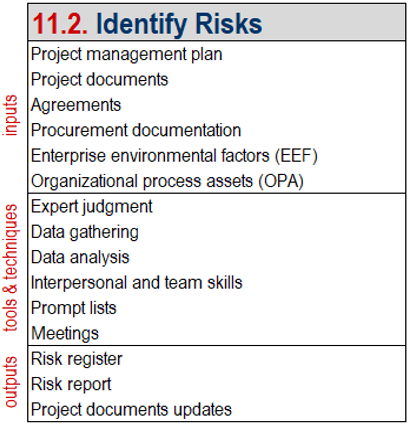
I can consult section 11.2., where I can find the process named “Identify Risk”. Sections 11.2.1 and 11.2.3 describe inputs and outputs, respectively –risk register is properly an output. I’m can read section 11.2.2 to recall tools and techniques more used by professional project managers: expert judgment, data gathering, data analysis, interpersonal and team skills, prompt lists and meetings.
The current edition of the guide can be represented as a set of 49 processes distributed in 5 process groups and 10 areas of knowledge:
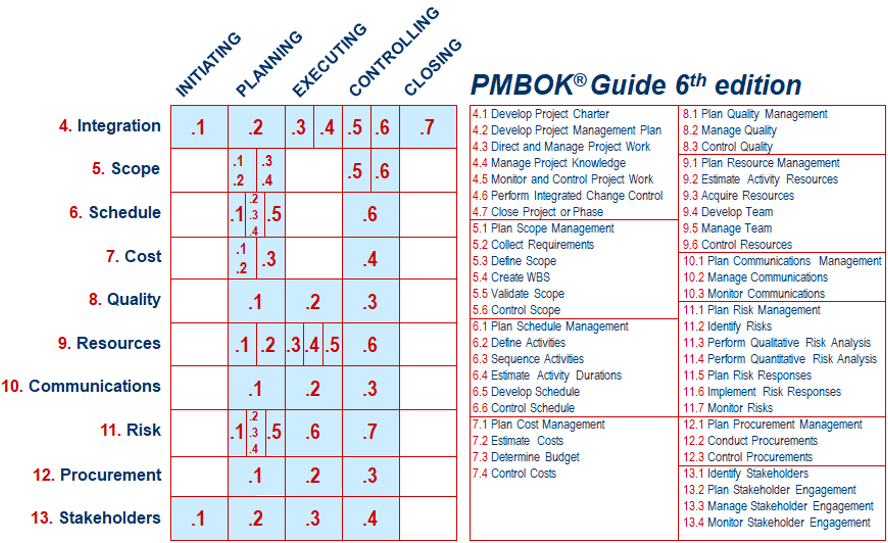
Project management knowledge areas are explained in chapters from 4 to 13:
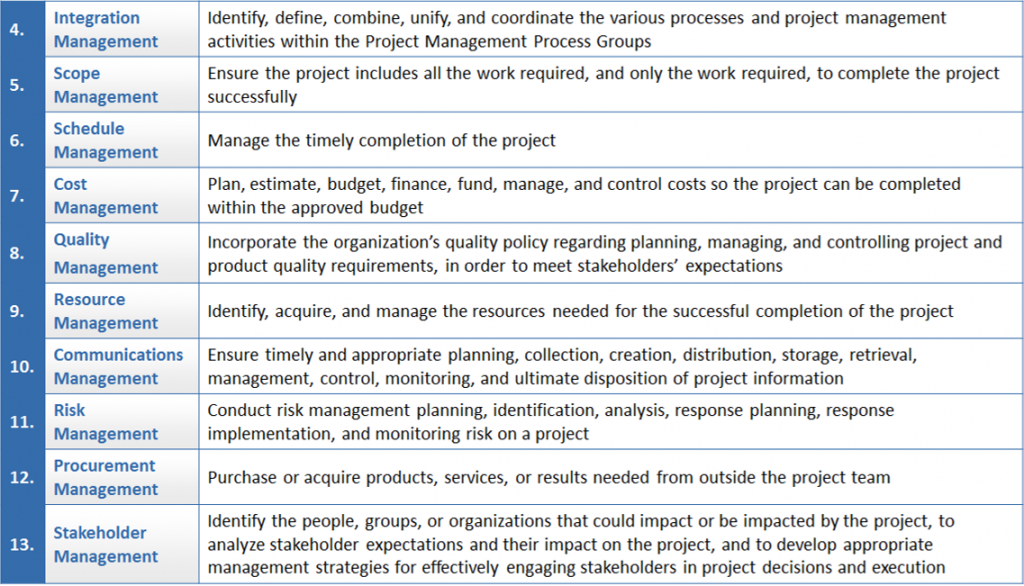
Considering project management objectives, the 49 processes can proceed –normally in sequence although they can overlap– following 5 process groups. Projects are first initiated, then planned, then executed and controlled, and finally, when deliverables have been accepted, they are formally closed:
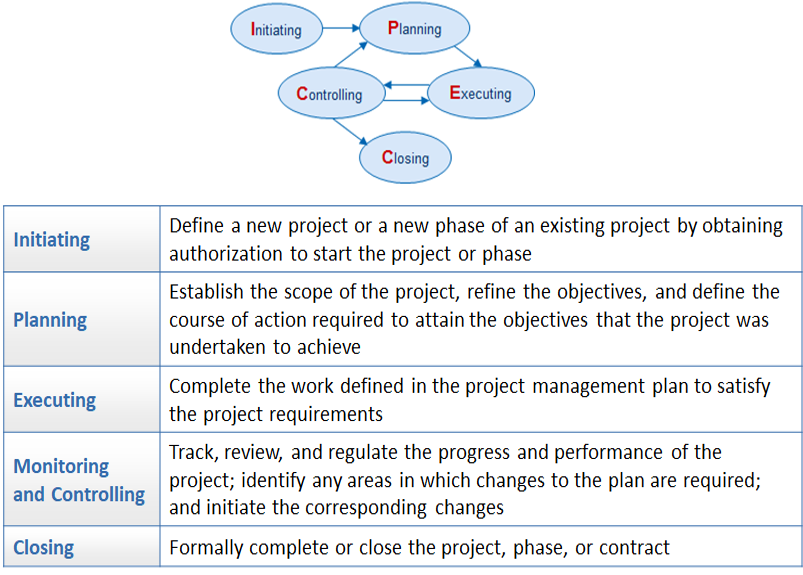
The guide describes the typical documents normally used in project management. They are not mandatory, but if you need them, you are advised to use the following names:

Additionally, the guide describes more than 100 tools and techniques, stating that there are many more, especially for agile projects.
Tools and techniques can be classified in several groups: data gathering (9), decision-making (2), communication skills (2), data analysis (27):

Data representation (15), interpersonal and team skills (17):
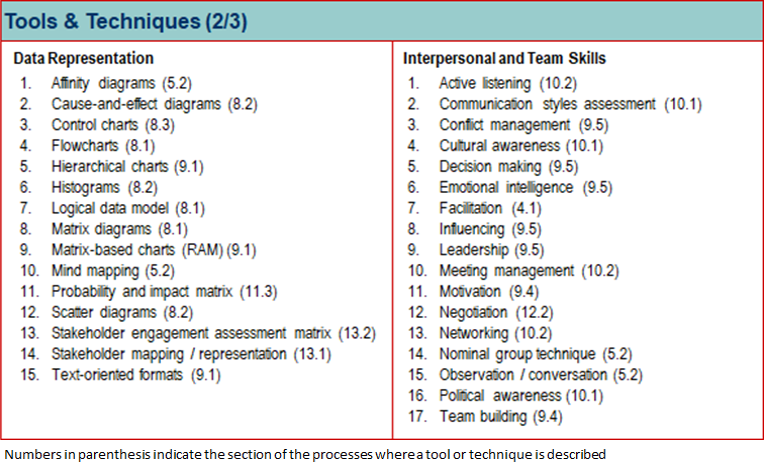
And finally, some of them that are not grouped (59):

The Project Management Body of Knowledge, by PMI, a.k.a. the PMBOK® Guide is applicable to perform professional management of all projects, not just de predictive projects using waterfall lifecycles. Methods applying agile projects are different, but we also need them to finish on time, on budget, meeting all the management goals. Agile projects use iterative incremental lifecycles. On each cycle they need many tools and techniques to perform value driven delivery, progressively elaborating requirements –user stories- thanks to the continuous feedback from stakeholders. Agile projects also need to produce a project charter for approval, they need controlling cost and schedule, each release formally closed before starting the next one, etc.
When managing professionally any project, be it predictive or agile, for any organization –functional, matrix, or projectized-, a long duration project or a short one, expensive or cheap, abundant or scarce resources, dealing with a small group of stakeholders or quite a few of them, with or without procurement, IT sector or another, etc., what to manage is more or less the same, how to manage is different.
With PMPeople you can practice the PMBOK® on your current project in your current organization, in an agile way. You can still manage urgent things. No need to wait for methodological changes, you can keep business as usual. You can move to the project economy making people collaborate. They don’t need to be PMP® certified to collaborate on projects professionally:
- If you are a project management trainer, you can make your students practice processes “learning by doing”.
- If you are an interim project manager, managing several projects at the same time for different companies, you can make stakeholders access the information they need via web or mobile application. They don’t need to meet you all the time to know how the project is going.
One day you will be shocked when some stakeholders start using the terminology like real professionals, communicating with you this way:
- “This work package has many risks. Are you sure it will end by April 25th, as baseline finish states?”
- “The last status report shows over cost of €2500. What can we do to increase CPI?”
- “I can see many planned hours in the capacity plan for the current release. Previous release had the same number of sprints but less hours. Are you planning to recruit more members for the development team?”
PMPeople put standardized project management processes into practice easily, thanks to people collaborating on each project, via web or mobile application:
- People can easily find the information concerning the project management process groups: initiation, plan, execution/control and closing.
- People can easily find the information concerning the project management knowledge areas: integration, scope, schedule, cost, resources, risks and procurement.
- People can follow predictive or adaptive lifecycles: It helps agile projects be managed to finish on time, on budget, controlling risk, facilitating team building, retrospectives, etc.
This is an excerpt from the book: Project Management with PMPeople. Download the whole chapter –PDF file– by clicking this link.
Download a free copy of this book in Spanish –PDF file, 920 pages– by clicking this link.
PMPeople is aimed to unify professional project management by these differential points:
- Designed by and for professional project managers, following professional project management standards.
- Online productivity –less meetings, less documents, less workflows– through distributed collaboration among 12 specialized roles: Organization Owner, 6 roles on demand management and 5 roles on supply management.
- Freemium product –unlimited time, unlimited users, only managers have to pay– usable via web and mobile application.
Start using PMPeople for free, for unlimited time and for any number of users. In premium organizations, only managers have to pay 20€ a month. Several roles –stakeholders, team members, sponsors and resource managers– are always free. You can increase or decrease your premium seats according to the organization actual needs. Premium organizations have access to our interactive support through Slack. Our servers are located in the EU. This software can also be hosted on customer premises.
Jose Barato
Related posts
Categories
- Business (16)
- Demand Management Roles (14)
- Frequently Asked Questions (7)
- Guide (26)
- People (23)
- Assignments (2)
- Feedback (2)
- Project Team (3)
- Tracking Time And Expenses (2)
- Process (9)
- Closing (2)
- Executing And Controlling (2)
- Planning (1)
- Project Management (67)
- Management Frameworks (18)
- Organization Owner (OO) (3)
- Project Economy (54)
- Tools (19)
- Supply Management Roles (5)
- Training (6)
- Uncategorized (1)




